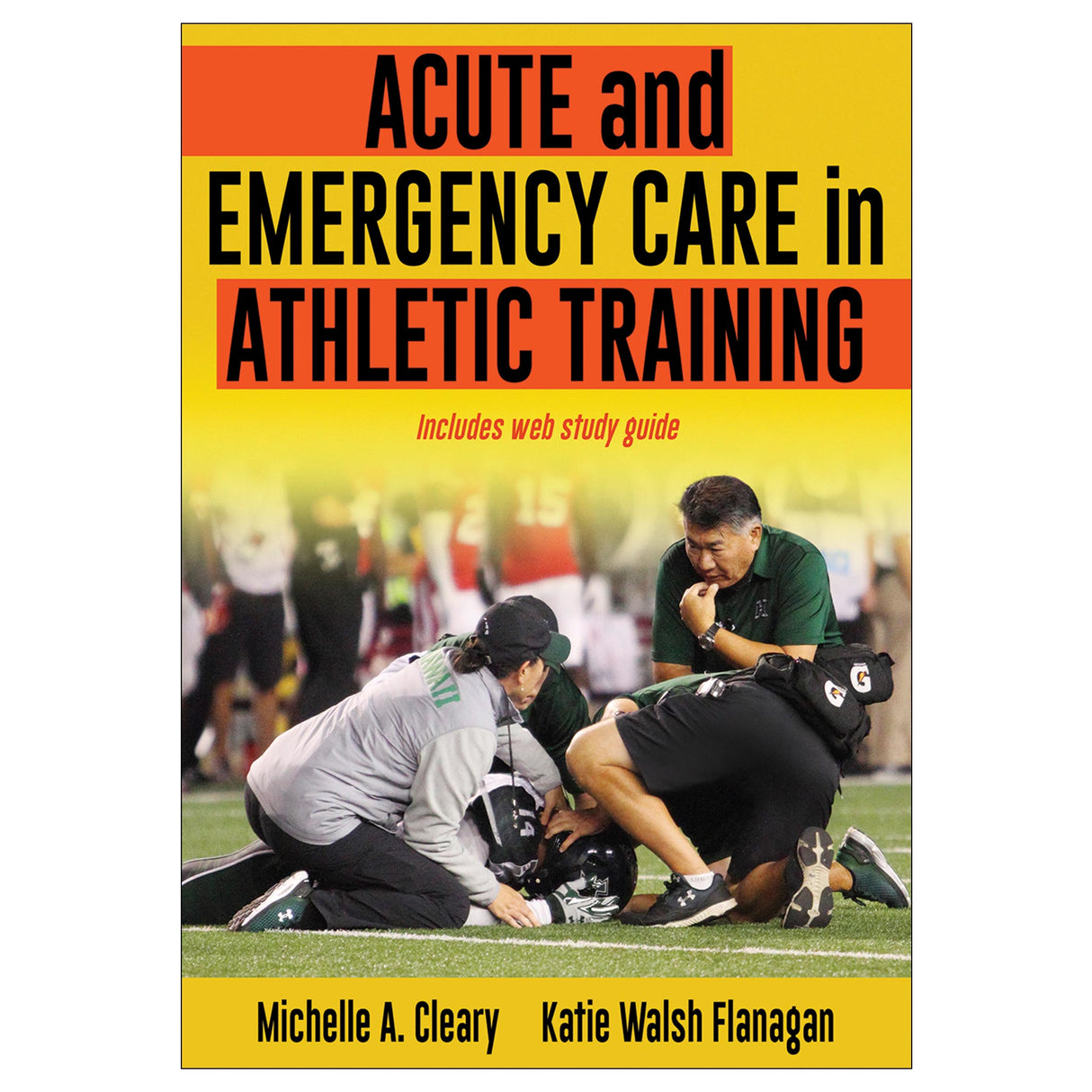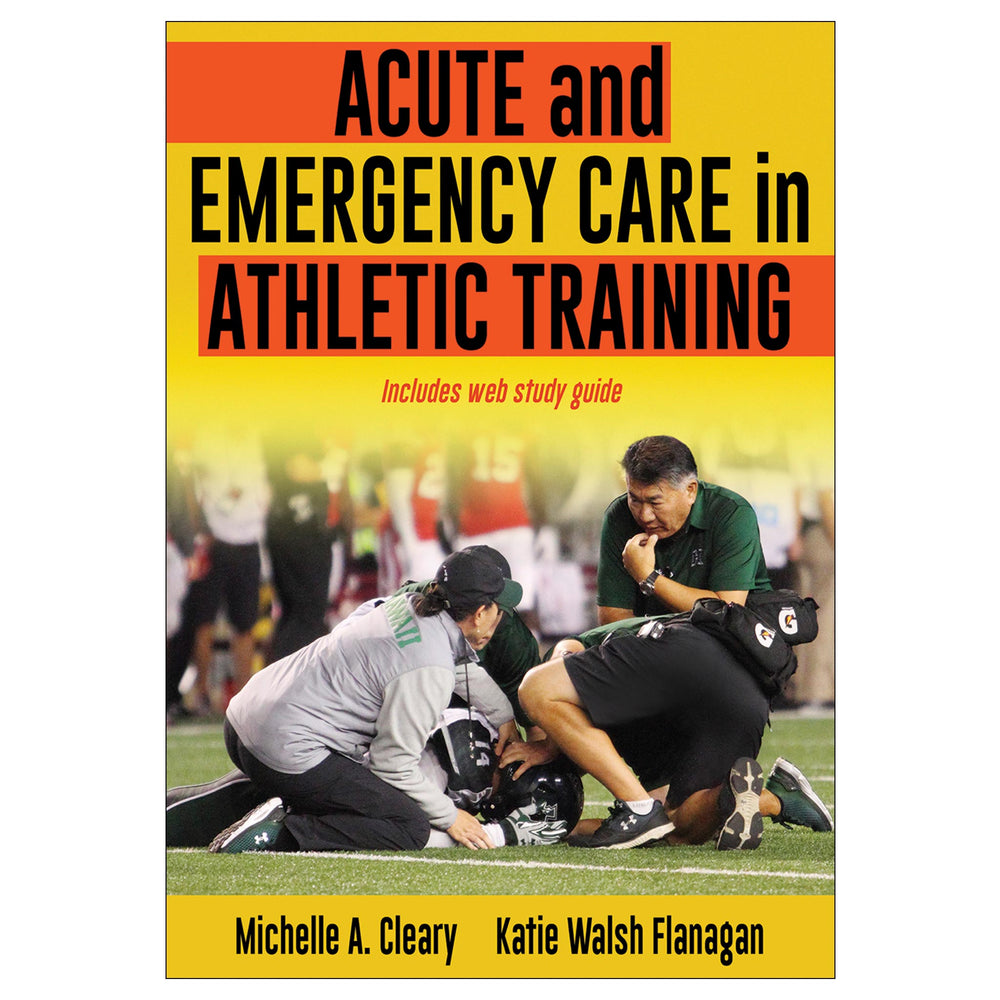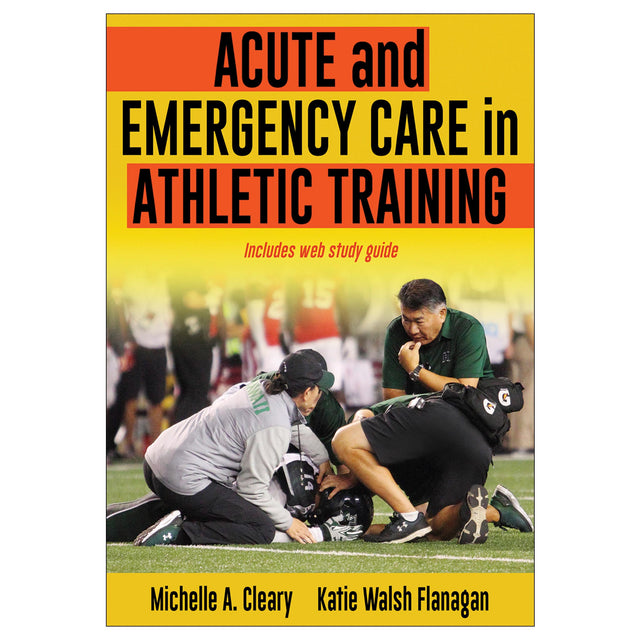Hardback With Online Resource
Acute and Emergency Care in Athletic Training With Web Study Guide
Author: Michelle Cleary, Katie Walsh Flanagan
$99.00 USD
Unit price
/
Unavailable
Hardback With Online Resource
$99.00 USD
$99.00 USD
Hardback With Online Resource
Athletic trainers are often the first ones on the scene when an individual sustains an acute injury. Therefore, knowing how to assess injuries and illnesses and begin treatment quickly is of vital importance for aspiring athletic trainers. Acute and Emergency Care in Athletic Training With Web Study Guide teaches students how to recognize and manage emergency conditions so they can provide appropriate patient care between the field and the emergency department.
Authors Michelle Cleary and Katie Walsh Flanagan take an interdisciplinary approach, drawing from literature, position statements, and guidelines from numerous professional health care organizations to offer current evidence-based clinical best practices. The book’s comprehensive coverage adheres to and incorporates guidelines from the Commission on Accreditation of Athletic Training Education (CAATE) and the Board of Certification (BOC), and it is one of the first textbooks to align with the competencies outlined in the CAATE 2020 standards.
To prepare students to effectively provide appropriate care before getting an injured or ill athlete to the hospital, Acute and Emergency Care in Athletic Training includes the following learning aids:
With a full-color presentation and more than 280 photos and illustrations, the text takes a systematic approach to acute and emergency care, with the content divided into two parts. Part I provides critical information on prevention and risk management strategies, including developing an emergency action plan, conducting an emergency examination, and administering emergency medications. Part II then provides the basics of emergency evaluations, describing how to examine, treat, and manage common acute injuries and illnesses to limit the severity of these potentially life-threatening conditions.
To aid instructors using Acute and Emergency Care in Athletic Training in the classroom, there is a full array of ancillaries, including a test package, an instructor guide with sample answers to the case study questions, and a presentation package plus image bank.
When an athlete is injured on the field of play, time is of the essence. Acute and Emergency Care in Athletic Training is an invaluable resource for training and preparing the initial responders to recognize critical situations and treat the acutely injured or ill patient.
Authors Michelle Cleary and Katie Walsh Flanagan take an interdisciplinary approach, drawing from literature, position statements, and guidelines from numerous professional health care organizations to offer current evidence-based clinical best practices. The book’s comprehensive coverage adheres to and incorporates guidelines from the Commission on Accreditation of Athletic Training Education (CAATE) and the Board of Certification (BOC), and it is one of the first textbooks to align with the competencies outlined in the CAATE 2020 standards.
To prepare students to effectively provide appropriate care before getting an injured or ill athlete to the hospital, Acute and Emergency Care in Athletic Training includes the following learning aids:
- Case studies in the web study guide offer practical scenarios that will facilitate critical thinking and decision-making skills.
- Clinical Skills sidebars guide students through the process of completing specific tasks such as splinting, wound care, and airway maintenance.
- Red Flag sidebars indicate areas where significant caution is warranted.
- Decision-making algorithms and decision trees lead students through selecting the most appropriate treatment option based on a patient’s signs and symptoms.
- Key terms are boldfaced in the text and are defined in the glossary section.
With a full-color presentation and more than 280 photos and illustrations, the text takes a systematic approach to acute and emergency care, with the content divided into two parts. Part I provides critical information on prevention and risk management strategies, including developing an emergency action plan, conducting an emergency examination, and administering emergency medications. Part II then provides the basics of emergency evaluations, describing how to examine, treat, and manage common acute injuries and illnesses to limit the severity of these potentially life-threatening conditions.
To aid instructors using Acute and Emergency Care in Athletic Training in the classroom, there is a full array of ancillaries, including a test package, an instructor guide with sample answers to the case study questions, and a presentation package plus image bank.
When an athlete is injured on the field of play, time is of the essence. Acute and Emergency Care in Athletic Training is an invaluable resource for training and preparing the initial responders to recognize critical situations and treat the acutely injured or ill patient.
Audience
Textbook for professional programs in athletic training and a reference for practicing athletic trainers. Part I. Introduction to Acute and Emergency Care in Athletic Training
Chapter 1. The Interprofessional Health Care Team
Characteristics of a Good Team
Sports Medicine Setting
Breakdowns in Teamwork
Effective Practices in Teamwork
Professional Attributes of Effective Health Care Providers
Therapeutic Behaviors
Summary
Chapter 2. Prevention and Risk Management Strategies
Risk Management
Infectious Diseases
Standard Precautions
Exposure Control Plans
Legal Responsibility
Summary
Chapter 3. Planning for Emergencies
Epidemiology of Medical Emergencies in Sports
Emergency Planning in Sports
Developing an Emergency Action Plan for Each Venue
Developing Acute Care and Emergency Protocols for Major Trauma and Medical Emergencies
Consulting With Institutional Authorities and Working With Local EMS Providers
Obtaining and Maintaining Emergency Equipment and Supplies
Review the EAP and Training Personnel
Communicating During an Emergency
Mass Care and Catastrophic Incidents
Post-Catastrophic Injury or Post-Critical Incident Plan
Evidence for Best Practices in Emergency Preparedness
Summary
Chapter 4. The Emergency Examination
Scene Size-Up
Initial Assessment
Identify the Chief Complaint or Concern
Focused Assessment
Monitoring the Critically Injured or Ill Patient
Reassessment
Patient Hand-Off
Evidence for Injury Scoring Systems
Summary
Chapter 5. Emergency Medications and Administration
Medical Direction and Oversight
Best Practices for Safe Administration of Medication
Medication Administration
Oral Medication Administration
Sublingual Medication Administration
Metered-Dose Inhaler Administration
Oxygen Administration
Nebulized Medication Administration
Emergency Medication Injection
Intravenous Access
Summary
Part II. Immediate Management of Acute Injuries and Illnesses
Chapter 6. Immediate Management of Bleeding, Shock, and Immunologic Emergencies
Overview of the Circulatory System
Hemorrhage
Shock
Anaphylactic Reactions and Immunologic Emergencies
Evidence
Summary
Chapter 7. Immediate Management of Musculoskeletal Injuries
Overview of the Structures
Classification of Injuries
Shoulder Dislocation
Elbow Dislocation
Finger Dislocation
Hip Dislocation
Knee Dislocation
Ankle Dislocation
Humeral Fractures
Colles’ Fracture
Pelvis Fracture
Femur Fracture
Tibia-Fibula Fractures
Ankle Fractures
Management of Lower-Leg Fractures
Compartment Syndrome
Ring Avulsion
Summary
Chapter 8. Traumatic Injuries to the Head and Face
Overview of the Head and Face
Overview of Head Injuries
Scalp Lacerations
Skull Fracture
Concussion
Chronic Traumatic Encephalopathy
Intracranial Pressure
Intracerebral Contusion
Epidural Hematoma
Subdural Hematoma
Headaches
Stroke
Seizures
Altered Mental Status
Overview of Facial Injuries
Corneal Abrasion and Foreign Objects in the Eye
Retinal Detachment
Hyphema
Tympanic Membrane Rupture
Facial Fractures
Temporomandibular Joint Dislocation
Dental Injuries
Laryngeal Injuries
Summary
Chapter 9. Traumatic Injuries to the Spine
Anatomy and Physiology of the Spine
Pathophysiology
Emergency Medical Care of Injuries to the Spine
Equipment Removal
Summary
Chapter 10. Injuries of the Thorax and Lungs
Overview of Anatomical Structures in the Thorax
Respiratory Assessment
Using Supplemental Oxygen
Airway Maintenance
Rib Fracture
Sternoclavicular Joint Injury
Pulmonary Embolism
Pneumothorax, Hemothorax, and Hemopneumothorax
Asthma
Summary
Chapter 11. Life-Threatening Cardiac Conditions
Overview of the Cardiovascular System
Epidemiology of Sudden Cardiac Death
Etiology and Pathophysiology of Acute Cardiac Conditions
Field Assessment Techniques for Emergent Cardiac Conditions
Immediate Management of Sudden Cardiac Arrest
Emergency Preparedness for Sudden Cardiac Arrest
Clinical Decision Making
Evidence: Cardiovascular Screening
Evidence: Factors Affecting Survival After Sudden Cardiac Arrest
Summary
Chapter 12. Injuries and Illnesses of the Abdominopelvic Region
Overview of Anatomical Structures in the Abdomen and Pelvis
Trauma to Abdominal Organs
Injuries to the Liver and Spleen
Injury to the Kidneys
Appendicitis
Acute Abdominopelvic Concerns for Female Athletes
Acute Trauma to Male Genitals
Summary
Chapter 13. Life-Threatening Metabolic Emergencies
Overview of the Anatomical Structures in Metabolic Emergencies
Diabetes
Hypoglycemia and Hyperglycemia
Summary
Chapter 14. Exertional Sickling and Rhabdomyolysis
Exertional Rhabdomyolysis
Sickle Cell Trait
Evidence: Factors That Increase Risk of Exertional Rhabdomyolysis
Summary
Chapter 15. Environmental Emergencies
Lightning Emergencies
Heat-Related Emergencies
Cold-Related Emergencies
Altitude-Related Emergencies
Summary
Appendix A. Model Exposure Control Plan
Appendix B. SCAT-5
Chapter 1. The Interprofessional Health Care Team
Characteristics of a Good Team
Sports Medicine Setting
Breakdowns in Teamwork
Effective Practices in Teamwork
Professional Attributes of Effective Health Care Providers
Therapeutic Behaviors
Summary
Chapter 2. Prevention and Risk Management Strategies
Risk Management
Infectious Diseases
Standard Precautions
Exposure Control Plans
Legal Responsibility
Summary
Chapter 3. Planning for Emergencies
Epidemiology of Medical Emergencies in Sports
Emergency Planning in Sports
Developing an Emergency Action Plan for Each Venue
Developing Acute Care and Emergency Protocols for Major Trauma and Medical Emergencies
Consulting With Institutional Authorities and Working With Local EMS Providers
Obtaining and Maintaining Emergency Equipment and Supplies
Review the EAP and Training Personnel
Communicating During an Emergency
Mass Care and Catastrophic Incidents
Post-Catastrophic Injury or Post-Critical Incident Plan
Evidence for Best Practices in Emergency Preparedness
Summary
Chapter 4. The Emergency Examination
Scene Size-Up
Initial Assessment
Identify the Chief Complaint or Concern
Focused Assessment
Monitoring the Critically Injured or Ill Patient
Reassessment
Patient Hand-Off
Evidence for Injury Scoring Systems
Summary
Chapter 5. Emergency Medications and Administration
Medical Direction and Oversight
Best Practices for Safe Administration of Medication
Medication Administration
Oral Medication Administration
Sublingual Medication Administration
Metered-Dose Inhaler Administration
Oxygen Administration
Nebulized Medication Administration
Emergency Medication Injection
Intravenous Access
Summary
Part II. Immediate Management of Acute Injuries and Illnesses
Chapter 6. Immediate Management of Bleeding, Shock, and Immunologic Emergencies
Overview of the Circulatory System
Hemorrhage
Shock
Anaphylactic Reactions and Immunologic Emergencies
Evidence
Summary
Chapter 7. Immediate Management of Musculoskeletal Injuries
Overview of the Structures
Classification of Injuries
Shoulder Dislocation
Elbow Dislocation
Finger Dislocation
Hip Dislocation
Knee Dislocation
Ankle Dislocation
Humeral Fractures
Colles’ Fracture
Pelvis Fracture
Femur Fracture
Tibia-Fibula Fractures
Ankle Fractures
Management of Lower-Leg Fractures
Compartment Syndrome
Ring Avulsion
Summary
Chapter 8. Traumatic Injuries to the Head and Face
Overview of the Head and Face
Overview of Head Injuries
Scalp Lacerations
Skull Fracture
Concussion
Chronic Traumatic Encephalopathy
Intracranial Pressure
Intracerebral Contusion
Epidural Hematoma
Subdural Hematoma
Headaches
Stroke
Seizures
Altered Mental Status
Overview of Facial Injuries
Corneal Abrasion and Foreign Objects in the Eye
Retinal Detachment
Hyphema
Tympanic Membrane Rupture
Facial Fractures
Temporomandibular Joint Dislocation
Dental Injuries
Laryngeal Injuries
Summary
Chapter 9. Traumatic Injuries to the Spine
Anatomy and Physiology of the Spine
Pathophysiology
Emergency Medical Care of Injuries to the Spine
Equipment Removal
Summary
Chapter 10. Injuries of the Thorax and Lungs
Overview of Anatomical Structures in the Thorax
Respiratory Assessment
Using Supplemental Oxygen
Airway Maintenance
Rib Fracture
Sternoclavicular Joint Injury
Pulmonary Embolism
Pneumothorax, Hemothorax, and Hemopneumothorax
Asthma
Summary
Chapter 11. Life-Threatening Cardiac Conditions
Overview of the Cardiovascular System
Epidemiology of Sudden Cardiac Death
Etiology and Pathophysiology of Acute Cardiac Conditions
Field Assessment Techniques for Emergent Cardiac Conditions
Immediate Management of Sudden Cardiac Arrest
Emergency Preparedness for Sudden Cardiac Arrest
Clinical Decision Making
Evidence: Cardiovascular Screening
Evidence: Factors Affecting Survival After Sudden Cardiac Arrest
Summary
Chapter 12. Injuries and Illnesses of the Abdominopelvic Region
Overview of Anatomical Structures in the Abdomen and Pelvis
Trauma to Abdominal Organs
Injuries to the Liver and Spleen
Injury to the Kidneys
Appendicitis
Acute Abdominopelvic Concerns for Female Athletes
Acute Trauma to Male Genitals
Summary
Chapter 13. Life-Threatening Metabolic Emergencies
Overview of the Anatomical Structures in Metabolic Emergencies
Diabetes
Hypoglycemia and Hyperglycemia
Summary
Chapter 14. Exertional Sickling and Rhabdomyolysis
Exertional Rhabdomyolysis
Sickle Cell Trait
Evidence: Factors That Increase Risk of Exertional Rhabdomyolysis
Summary
Chapter 15. Environmental Emergencies
Lightning Emergencies
Heat-Related Emergencies
Cold-Related Emergencies
Altitude-Related Emergencies
Summary
Appendix A. Model Exposure Control Plan
Appendix B. SCAT-5
Heat-related emergencies in athletes
Safe helmet removal after spinal injury
Sternoclavicular joint injury
Traumatic injuries to the head and face: Subdural hematoma
Safe helmet removal after spinal injury
Sternoclavicular joint injury
Traumatic injuries to the head and face: Subdural hematoma
All ancillaries are free to adopting instructors and available online.
Instructor guide. Includes chapter summaries, ideas for activities, suggested websites, and sample answers to the case study questions.
Test package. Contains more than 400 questions in true-or-false, fill-in-the-blank, and multiple-choice formats that instructors can use to build tests and quizzes.
Presentation package plus image bank. Includes more than 720 PowerPoint slides that cover the content of each chapter and can be used for class discussion and presentation. The slides in the presentation package can be used directly within PowerPoint or be printed to make transparencies or handouts for distribution to students. Instructors can easily add, modify, and rearrange the order of the slides.
The companion image bank includes most of the figures and tables from the text, sorted by chapter. These can be used in developing a customized presentation based on specific course requirements.
Web study guide. Provides two case studies per chapter. These case studies highlight the specific application of examination, management, and return-to-participation considerations of specific acute or emergent medical conditions. The case studies help athletic trainers make clinical decisions, determine appropriate techniques, and apply prevention strategies taught in the text. Each case study is followed by several analysis questions that facilitate critical thinking and decision-making skills.
Instructor guide. Includes chapter summaries, ideas for activities, suggested websites, and sample answers to the case study questions.
Test package. Contains more than 400 questions in true-or-false, fill-in-the-blank, and multiple-choice formats that instructors can use to build tests and quizzes.
Presentation package plus image bank. Includes more than 720 PowerPoint slides that cover the content of each chapter and can be used for class discussion and presentation. The slides in the presentation package can be used directly within PowerPoint or be printed to make transparencies or handouts for distribution to students. Instructors can easily add, modify, and rearrange the order of the slides.
The companion image bank includes most of the figures and tables from the text, sorted by chapter. These can be used in developing a customized presentation based on specific course requirements.
Web study guide. Provides two case studies per chapter. These case studies highlight the specific application of examination, management, and return-to-participation considerations of specific acute or emergent medical conditions. The case studies help athletic trainers make clinical decisions, determine appropriate techniques, and apply prevention strategies taught in the text. Each case study is followed by several analysis questions that facilitate critical thinking and decision-making skills.





